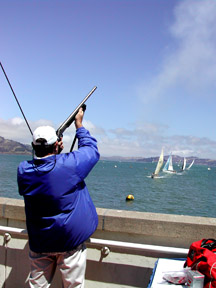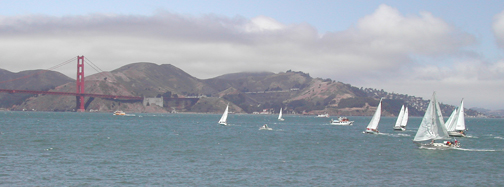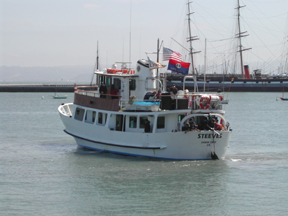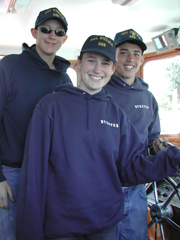 They’re
Off
They’re
OffBy Mary Swift-Swan
West Marine Pacific Cup is the fun 2,070
nautical-mile sailboat race to Hawaii. The 13th biannual
regatta began June 28, at 11:45 a.m., in a staggered start
series with the last flight taking off July 2 at 3:45 p.m.
At press time, of over 60 entrants who paid entry fees, only
54 were able to get their crew and vessels ready and able to
pass the careful inspection criteria for safety afloat for
the demanding voyage. It takes a week to see who actually
makes it across the start line. Boats are varied in type and
speed from slow cruisers with an allowance of 8/19:36:00,
that is 8 days, 19 hours and 36 minutes from the fastest
boat, the beautiful custom mega yacht of 140’, Mari Cha IV,
that is expected to smash all previous records in making the
crossing.
 |
|
Navigator / Project Manager Jef
d’Etiveaud |
Through the first half of July, over the
duration of the race, those interested in the progress and
fate of these brave sailors can log on to their web site at
www.pacificcup.org to see the charted progress of each
ocean-going yacht and read daily reports collected by and
posted from the communications boat run by the Sea Scouts,
Steeves. The Steeves went out the Gate following class B on
June 28th, sailing the course of the race to Hawaii.
West Marine Pacific Cup has the best
safety record of all the truly challenging ocean races. The
race management has multiple vessel inspection check points
and assigns boat nannies to guide each vessel’s preparation.
This system was developed by past participants to help new
and returning participants registered in the race to ensure
arrival on the other side and back home with vessel and crew
having a grand adventure. Skippers, and key members of each
crew, also must attend a six-month series of seminars on
many topics of safety, including medical emergencies far
from any medical help; rigging failures; and how to keep a
vessel afloat and under way to make land fall; the U.S.
Coast Guard demonstrates open water rescues when an incident
happens near a coast; and liferaft companies show how to
inflate and board in an emergency. The many subjects of the
seminars also include key factors in interpreting wind and
recognizing dangers, like hurricanes, from weather fax
information taken from satellite downloads plus what has
worked and best guesses for the upcoming race navigation
strategies. The seminars are run by sailing and subject
experts from around the country, plus shared experiences
from past participants. Attending the monthly meetings also
allows participants to meet each other before the week of
arrival parties, two thirds of the way across the big pond.
 The
race to Hawaii takes between 8-16 days, depending on the
different boat designs. Mari Cha IV is out to beat Roy
Disney’s record of 6 days, 14 hours and 23 minutes. They can
maintain speeds of 30 knots and have the ability to attain
40 knots. The 140’ long, 33’-wide vessel built for speed
hopes to smash all previous records by making the crossing
in 5 days. What about getting home? For those who do not
ship home their vessels, a cruiser heading home can take up
to 20 days, where a race-type vessel can make it back
between 15-17 days. They usually sail toward Seattle then
work over the top of the Pacific High, finally head home to
avoid being becalmed in the middle for days.
The
race to Hawaii takes between 8-16 days, depending on the
different boat designs. Mari Cha IV is out to beat Roy
Disney’s record of 6 days, 14 hours and 23 minutes. They can
maintain speeds of 30 knots and have the ability to attain
40 knots. The 140’ long, 33’-wide vessel built for speed
hopes to smash all previous records by making the crossing
in 5 days. What about getting home? For those who do not
ship home their vessels, a cruiser heading home can take up
to 20 days, where a race-type vessel can make it back
between 15-17 days. They usually sail toward Seattle then
work over the top of the Pacific High, finally head home to
avoid being becalmed in the middle for days.
 There
is earnest effort, and for most boats, great expense to
prepare for the longest open water race, without anywhere to
stop, on the planet. If a boat is not already set up for
such a voyage, the required safety gear and vessel/crew
outfitting easily runs between $30,000 and $40,000, and can
be more. Once set up, however, means that repeating the race
two years later only costs $5,000 to $10,000 for
provisioning (food, water, and fuel there and back or cost
of shipping the boat back), plus traditional vacation costs
for one to two weeks spent in Hawaii, as long as nothing
major breaks.
There
is earnest effort, and for most boats, great expense to
prepare for the longest open water race, without anywhere to
stop, on the planet. If a boat is not already set up for
such a voyage, the required safety gear and vessel/crew
outfitting easily runs between $30,000 and $40,000, and can
be more. Once set up, however, means that repeating the race
two years later only costs $5,000 to $10,000 for
provisioning (food, water, and fuel there and back or cost
of shipping the boat back), plus traditional vacation costs
for one to two weeks spent in Hawaii, as long as nothing
major breaks.
Why not just fly over? For some, the money
is well spent because it is the start of a long-held dream
of experiencing the voyage to where all the drinks have
umbrellas. From Hawaii, they continue across the Equator to
French Phoenicia or New Zealand. For most, it is not getting
to a place so much as the voyage. It is the dream of
crossing an ocean in a small boat under command of a tight
group of people who sail 24 hours a
 day
in shifts till they make land fall. Visions of dolphins
jumping off the bow just won’t leave them. After such a
race, memories of flying fish jumping across the deck at
sunrise, the excitement of catching a fish at sea, and the
“Oh, my God” of where to put it that follows a breakfast of
sushi and sashimi. There is something special for some when
the sun rises and sets without land in sight. Most never
forget having to brace knees to keep them from giving way
when working on deck in a howling squall at 4 a.m. or
driving while plummeting down a mountain of water in the
pitch black of night through driving rain only to come out
the other side of the squall to see the gain those
frightening moments gave. It can strain or solidify
relationships. More than one couple has ended
day
in shifts till they make land fall. Visions of dolphins
jumping off the bow just won’t leave them. After such a
race, memories of flying fish jumping across the deck at
sunrise, the excitement of catching a fish at sea, and the
“Oh, my God” of where to put it that follows a breakfast of
sushi and sashimi. There is something special for some when
the sun rises and sets without land in sight. Most never
forget having to brace knees to keep them from giving way
when working on deck in a howling squall at 4 a.m. or
driving while plummeting down a mountain of water in the
pitch black of night through driving rain only to come out
the other side of the squall to see the gain those
frightening moments gave. It can strain or solidify
relationships. More than one couple has ended
 their
relationship on arrival. A few races ago during a
well-attended chat time, following the daily radio check-in
with the Communication boat, one man asked his sweetheart
who was sailing on a different boat to marry him. Every
racer held their breath till she said in choked response
through joyful tears, “Yes, yes I will.” Recognizing that
life is now, each and every minute of every day, and that
they all count, can be a life-changing experience.
their
relationship on arrival. A few races ago during a
well-attended chat time, following the daily radio check-in
with the Communication boat, one man asked his sweetheart
who was sailing on a different boat to marry him. Every
racer held their breath till she said in choked response
through joyful tears, “Yes, yes I will.” Recognizing that
life is now, each and every minute of every day, and that
they all count, can be a life-changing experience.
Bay Crossings wishes each and every racing
and delivery sailor and the intrepid Sea Scouts watching
over them all the best of voyages all the way around.
Readers who wish to help the Sea Scouts raise the $3,000
needed to get home from this grand adventure, can contact
Ann McDougall at Ann McDougall Communications, 408-499-5328,
or ann@michannpartners.com.